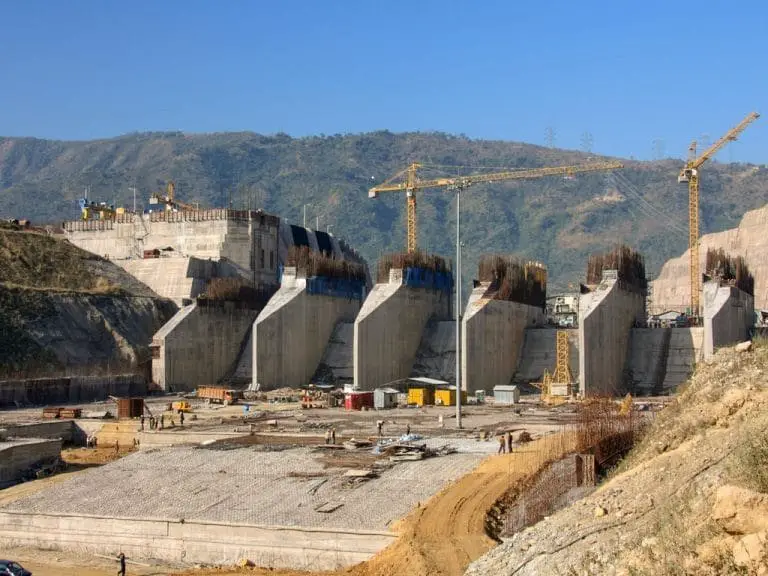Sitting on a total area of 542 acres, spanning 1 kilometer long and 40 meters deep, the Thiba dam in Kirinyaga county, Kenya, has finally filled up. This was announced by Mr. Daniel Nzonzo, the head of corporate communications at the National Irrigation Authority. Nzonzo said that the dam took approximately three and a half months to be filled with 15.6 million cubic meters of water.
Overflows into the river channel are directed into the spillway, which acts as a safe evacuation route. According to Mr. Nzonzo, the river’s hinterland has a 180 cubic meter catchment in the rainy season, most of which will flow via the spillway.
Through the spillway, four cubic meters of water per second are released from the dam back into the river. He said that there isn’t a risk that there will be a spillover into the area, that the dam will break, or that floods will occur. Due to their strength, the walls can withstand water.
Thiba Dam to boost the region’s irrigation
The dam is expected to boost the region’s irrigation, in which rice farming is primarily carried out.
According to the National Irrigation Authority, an additional 10,000 acres of land are expected to be added to the Mwea irrigation scheme. The land will be used for the cultivation of rice since there is enough irrigation water.
The dam’s capacity to provide irrigation during dry seasons to local rice farmers was good news. During dry seasons, according to Nzonzo, the gates of the dam will be opened to let water flow to the rice paddies at the Mwea Rice Scheme. This is to maintain the output.
Background
The Thiba Dam project also referred to as Rukenya Dam, is a dam currently under construction in Rukenya, Kirinyaga County, Kenya. The dam will be 1 km wide and 40 meters high. The dam’s reservoir will at least have an area of 542 acres, having a water storage capacity of around 15 million cubic meters.
The main purpose of the dam is to raise the land under irrigation in the Mwea Irrigation Scheme. The dam project is funded by the Government of Kenya partnered with the Japan International Cooperation Agency. The cabinet proposed the dam construction as a Vision 2030 project.
Upon completion, the dam is set to provide water to the Mwea irrigation scheme and make sure farming goes on year in and year out uninterrupted. The development was earlier expected to take 3 years and seven months and it would have been done around July 2020.
Read also: The WestConnex project in Sydney Australia.
Reported earlier
Oct 2014
Mega dam to be constructed in Kenya at US$ 146m
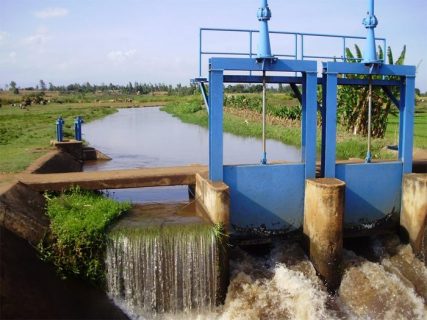
The Japanese government is going to fund the construction of a mega dam on the Thiba River to curb water shortages in the Mwea Irrigation Scheme. The project is going to be undertaken by the National Irrigation Board at a cost of US$ 146m.
The dam construction project will start in January 2015, and be completed by June 2016. A consultant has been hired by the board to review the design and supervise construction works at the site. The dam construction project shall also include the construction of major irrigation and feeder canals up to the farms
The huge Thiba dam, once completed, shall provide irrigation water to the 7,952Ha Mwea Irrigation Settlement Scheme, which produces over 60 percent of the rice grown in Kenya. The dam would be able to boost rice production in the area and allow the production of other crops such as maize and vegetables. Money from annual sales attained from the completed dam construction project is also expected to double from the current US$ 28m to US$ 46m.
The planned dam construction project will give birth to one of the country’s greatest man-made dams. Farmers and residents of the area where the dam will be constructed have already been relocated and compensated by the government.
The irrigation board is currently rehabilitating the scheme and improving the infrastructure there at a cost of US$ 6.1m from the World Bank.
November 2017
Kenya launches construction of US $194m Thiba Dam
Kenya has recently launched the construction of the US $194m Thiba Dam in Kirinyaga County. The ceremony was presided over by President Uhuru Kenyatta. Water and Irrigation Cabinet Secretary Eugene Wamalwa was also present at the groundbreaking ceremony.
The project is expected to reach completion in the next three years. Part of the dam’s funding will come from the Japanese Government. They have since kept their initial pledge of US $11.64m. The Kenyan Government will contribute US $48.5m.
The Japan International Cooperation Agency (Jica) will oversee as well as support the construction of the dam. According to the Deputy President, the dam is the first of 57 others that the government has pledged to construct in the next five years as part of the Jubilee manifesto.
The project is also expected to create employment for local youth. He added that part of the money allocated to the project must go to residents.
Compensation
The project had also been delayed by court battles at the expense of rice farmers who put their hopes on its actualization to boost their farming.
The court wrangles emerged over compensations of hundreds of families who were displaced to pave the way for the dam’s construction. Some were reported to have started moving back to the area at some point.
The 132 farmers identified for compensation also argued that the irrigation board only compensated landowners. Their grievances were that their children and other vulnerable groups were left out. Most of the affected families have already been compensated but 20% are yet to receive payment. However, the government said it is addressing the matter.
October 2019
The construction was suspended in October 2019 due to a lack of funding. It resumed later in January 2020 after a new $6 million release.
Nov 2019
Kenya halts construction of US $195m Thiba Dam
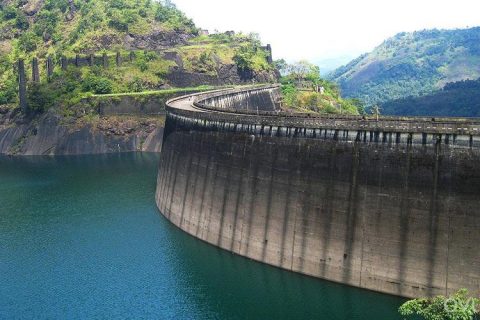
Construction works on the US $195m Thiba Dam in Kirinyaga County have been halted. Central Regional Commissioner Wilfred Nyangangwa confirmed the report and said that the close down, was attributed to cash flow from the treasury.
He explained that the project was halted due to failure to pay the contractor, Strabag Company. This resulted in over 300 workers previously engaged by the contractor being suspended. The government has not remitted money in excess of US $10m. The commissioner has however assured that the problem will be solved soon.
“Construction has temporarily been suspended due to problem of resources. As the Chair of the Regional National Government Project Implementation Team, I have impressed upon officials at the treasury to address the issue. Once the problem is addressed, the project will resume in the shortest time possible, we are taking the matter seriously,” said Wilfred Nyangangwa.
Also Read: Construction of US $14bn Grand Inga dam in Congo on track
Thiba Dam
The Thiba Dam project’s aim is mainly to boost rice production in Kirinyaga County and improve the country’s food security. It is also a major solution to the water shortage in Mwea. It involves major irrigation and feeder canals up to the farms.
Upon completion, it is expected to provide irrigation water to the 7,952Ha Mwea Irrigation Settlement Scheme, which produces over 60% of rice grown in Kenya. The dam will also allow the production of other crops such as maize and vegetables. Money from annual sales attained from the completed dam is also expected to double from the current US $28m to US $46m. The project was expected to be completed in 45 months. It is currently 30% complete.
The construction of the Thiba Dam is being financed in partnership with the Japanese Government through Japan International Cooperation Agency (JICA). When fully complete, the Dam will be 40m tall and 1km long and is expected to have a holding capacity of 15 million cubic meters.
Data from the Kenya Bureau of Statistics shows that Kenya imports rice every year largely from Pakistan, Thailand, India, and Vietnam. It is estimated that with the completion of the Thiba Dam, the amount used for import will be reduced by half or even more if it succeeds in increasing the water supply, to allow for three seasons of rice per year, unlike the current season.
Jan 2020
Kenya releases US $6m to revive Thiba Dam Project
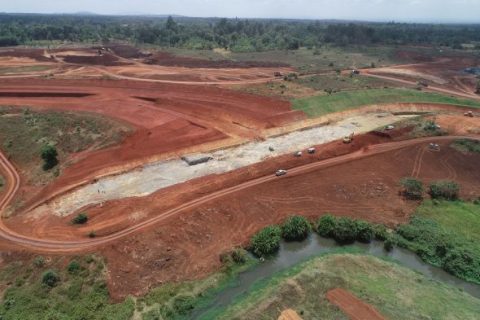
The Kenyan government has released US $6m to revive the construction of Thiba Dam which was halted late last year due to a lack of funds. According to the Strabag Company, all workers who were sent home after the mega-project halted have been recalled.
“We have resumed construction work after the government availed some of the funds,” James Karanja, a Senior Company Manager. However, Mr. Karanja also confirmed that the money was not enough and the company will be demanding some more from the government. “We expected to receive US $20m but the government gave us only US $6m which is not enough to complete the project,” he said.
Also Read: Construction of Kunzvi Dam in Zimbabwe to begin this year
August 2020
Construction work for the Sh20 billion Thiba dam was on course with December 2021 targeted as the date of completion.
The scheme Engineer Stephen Mutinda stated that they were at the time concentrating on building the dam wall after they already had diverted the river. He added that the diversion works were standing at 84% and they were still embarking on creating the spillway which was at 18%
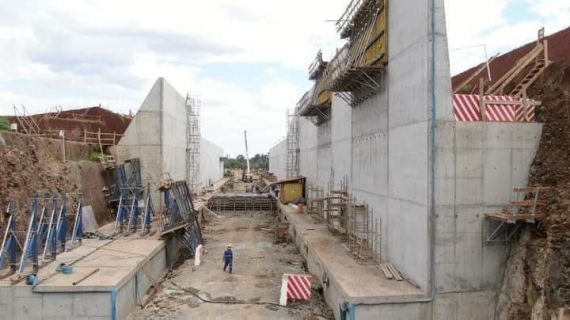
September 2020
The government stated that it would not extend the contract period for the construction of the Thiba mega-dam, whose completion was expected in late, 2021. Ministry of Water and Irrigation Cabinet Secretary Sicily Kariuki revealed to Strabag Company which has been on-site since November 2018 to make sure all the lost time was recovered and deliver the scheme on schedule.
June 2021
Kenya’s Thiba dam to be operational by December
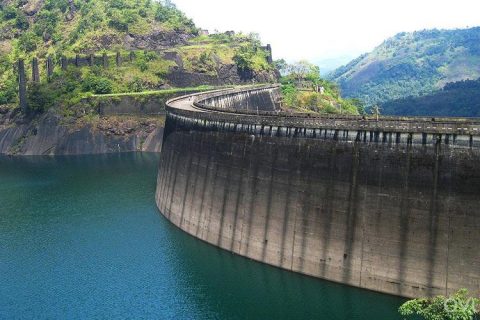
Thiba Dam Project Engineer, Stephen Mutinda revealed that the Dam construction would be complete by December 2021, ready to control flood waters and offer water for irrigation. Mutinda stated immersing the facility with water would start immediately in readiness to give irrigation water to rice farmers in the Mwea irrigation scheme.
He added that the project would have been ready earlier was it not for the delay in the master list approval which took nine months, translating to a lower mobilization by the contractor and duties, taxes, and levies payment. He said at the time, the contractor had paid some duties amounting to Sh 372 million to the Kenya Revenue Authority (KRA) which had affected the contractor’s project cash flow.
From the Sh 372 million requested for reimbursement, only Sh 273 million was approved by the Cabinet Secretary (CS) National Treasury for a refund but the contractor has not received the money. Mutinda told the County Development Implementation and Coordination Committee (CDICC), that they have deployed mitigation measures to ensure the scheme will be completed as planned.
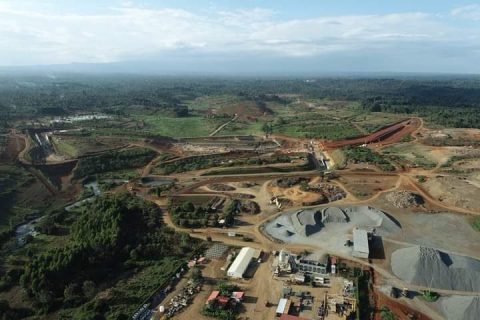
August 2021
Construction works on the dam were again halted. Central Regional Commissioner Wilfred Nyangangwa revealed the report saying that the close down was brought by the cash flow from the treasury.
He added that the scheme halted due to the failure to remunerate the contractor, Strabag Company. This led to over 300 workers previously engaged by the contractor being suspended. The development is currently at 30% completion.
January 2022
Thiba Dam in Kenya, to Be Filled With Water Starting From March 2022
Thiba Dam also known as Rukenya Dam project engineer Eng. Stephen Mutinda has announced that the facility, whose construction is already 91% complete with remaining work, (including the construction of links to the existing road network, water draw-off, and safe floodwater drainage) still underway, is ready for flooding come the rainy season which begins in March this year.
Also Read: Ang’ololo Water Resources Development Project to Benefit Thousands in Kenya & Uganda
According to Eng. Mutinda, were it not for the low volume of water in the target river, flooding would have commenced earlier and water would be ready for the farmers by May this year. The engineer also said that the project would have been fully completed before the end of December last year were it not for the delay in the approval of the master list, which took nine months to approve translating to slow mobilization by the contractor, and in the payment of duties, taxes, and levies.
Another hiccup to the project according to Eng. Mutinda was the inadequate budget allocation by the National treasury at one time that led to the suspension of works for about three months from 1 October 2019 to 7 January 2020.
Thiba Dam reservoir boost Mwea Rice farmers
Built at a cost of close to US176M, the 40-meter tall and 1 km long dam creates a reservoir that has the capacity to hold approximately 15 million cubic meters of water, which will allow a second harvest every year in the Mwea Rice Irrigation scheme and the surrounding cultivable area.
Currently, the Mwea Irrigation scheme has 25,000 acres under rice cultivation, and it is being expanded by 10,000 acres in the Mutithi section. Upon completion of this expansion, a total of 35,000 acres of land will be under cultivation, which means a double production of paddy rice.
According to the Thiba Dam Project manager, James Karanja, the income from the crop, which stands at about US$ 79.2M, will also shoot up threefold to approximately US$ 176M per year, and improve the wellbeing of the farmers as a result.
Jun 2022
Thiba Dam in Kenya Begins Supplying Water to Mwea Rice Irrigation Scheme
Thiba Dam in Kenya is reportedly supplying water to the Mwea rice irrigation scheme in Kirinyaga. The 15.6 million cubic meters capacity dam began supplying water to the scheme in June this year. At the time it was halfway complete following the start of its impounding process in late May.
Speaking at the impounding process launching ceremony, Gitonga Mugambi said that the lowering of the Thiba Dam gate outlet to mark the official commencement of water impounding at the dam was a major milestone for the project. Mugambi is the CEO of the National Irrigation Authority.
Thiba Dam construction completed ahead of time and below budget
The dam, whose construction began two years ago and was concluded in June, approximately two months before the deadline. The project cost taxpayers Sh400 million less than the originally projected cost of Sh8.2 billion. This was revealed by the National Irrigation Board (NIB) officials led by Engineer Charles Muasya.
Speaking to the Public Service Commission of Kenya (PSCK) Mr. Muasya explained that 24-hour shifts, improved supervision, and the introduction of work on Sundays and public holidays enabled them to finish the project ahead of schedule at a cost of Sh7.8 billion.
Despite major challenges that could have caused the delay of the project, the German company Strabag International GmbH was able to complete the dam within the allotted timeframe.
For instance, proper water draw-off and secure floodwater drainage would have been completed by December 2021 if it weren’t for the gate valve that regulates the flow of water back to the river’s late arrival from Germany.
